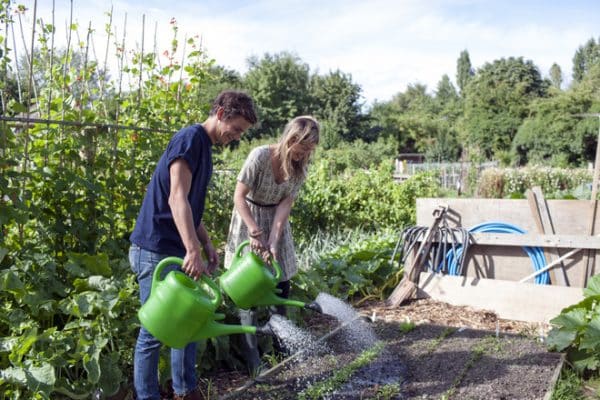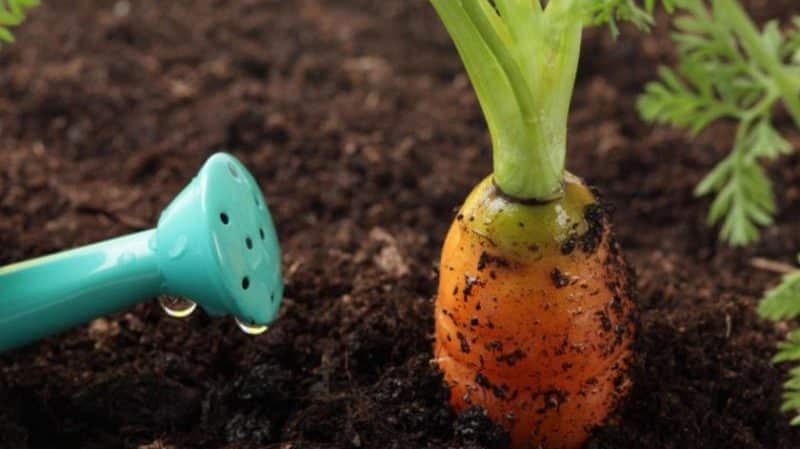Instructions for watering carrots in August in open ground for beginner gardeners
Growing carrots is a simple process, but still requires a certain approach. For example, novice gardeners are concerned about the regularity of watering and the amount of water in August if the vegetable grows in open ground. For this purpose, there are recommendations and instructions for irrigation at certain stages of plant development. From the article you will learn how often to water carrots in August.
Features of watering carrots in August in open ground
Early carrot Usually they start digging them up for fresh consumption or preparations already in August. In this case, the vegetable does not need watering. But later varieties with a ripening period of 110-130 days continue to grow in the beds until the end of September - beginning of October, depending on the climatic conditions of the region and the first frosts.
And although the root crops complete their formation in August, they continue to grow and fill out. At this time, it is important to be careful about watering, since uneven moisture leads to the formation of cracks and deformation of root crops.
How to water carrots correctly
It is important to observe the frequency of watering and take into account the degree of soil moisture in the garden.
Frequency and abundance
In August, when the root crops are almost formed, the amount of watering is reduced and the volume of water used is increased. If the frequency of watering is left the same, the carrots will become watery and hairy due to the many lateral roots.

If you completely stop moisturizing root vegetables, they will crack and become woody. Usually they consume 220-270 liters of water per 100 square meters. m, or 20-30 liters per 1 sq. m, with watering once every 7-10 days.
It is not difficult to determine whether the crop is watered correctly: the soil should not be dry or too wet. By the end of August, irrigation is reduced to a minimum, waiting for harvest harvest.
Technology
To obtain a decent harvest of beautiful and tasty carrots, experienced gardeners use the following techniques when watering:
- Irrigate evenly over the entire area of the land plot and ensure that during each procedure the soil is moistened to a depth of at least 25-30 cm.
- Root crops are watered at the root at sunset.
- Water is supplied in small portions intermittently to prevent waterlogging of the soil.
- In the heat, greens are also refreshing, but only in the evening. Plants are watered from a watering can with a shower head.
- Between waterings, loosen the soil to destroy the crust, improve aeration and soil permeability for incoming water.
- To reduce the number of waterings, the beds are mulched with organic material.
It is best to use a drip irrigation system for irrigation. This method allows water to seep directly to the root and thoroughly saturate the soil. At the same time, water does not spill over a large area and does not evaporate due to high summer temperatures.
Attention! You cannot water carrots with a hose without a special nozzle, as strong water pressure will injure the plants.
Water temperature
Many summer residents are faced with a problem: too cold water, which is extracted from a well or borehole using a pump. Roots watered with such water in hot weather are not able to absorb it. It turns out that watering does not save plants from dehydration.
If root crops are watered with too cold water in the evening, when the ground is still warm, the plants may get a shock and stop developing. They will become more susceptible to diseases, in particular root rot.
To moisturize, use warm water heated by the sun. Its supply is made in any containers: a bathtub, a barrel, various containers. When the liquid warms up to air temperature, begin watering.
Reference. Carrots will turn out very hard and unsuitable for eating if cold water is used for irrigation.
Lack or excess watering
Excessive or insufficient watering has a negative impact on the taste and quality of the fruit.
Signs
In case of overwatering:
- On root crops, a large number of lateral roots and a kind of hair are formed, and the central root gradually dies off.
- The carrots are rotting.
Insufficient watering in August negatively affects the size and quality of root crops. This causes them to remain small, become woody, and crack.
Reference. Excessive watering, which causes increased humidity in the beds, is one of the main causes of pest invasion, including carrot flies.
What to do
Any gardener will be dissatisfied with such a harvest - tasteless, with defects and flaws. Therefore, it is important to carefully monitor the periods of crop growth and development and adjust the application of moisture.
You can count on an abundant harvest of large and juicy carrots only if you water moderately and evenly at all stages of the plant’s growing season.
Watering in hot and rainy weather

During the heat Carrot plantings are irrigated regularly, preventing the appearance of crusts and cracks in the soil.If beds with baked soil are watered abundantly, all the root crops will burst from the sudden moisture. During periods of elevated air temperatures, water early in the morning or after 17.00 so that the water does not have time to evaporate under the hot sun and can penetrate deep into the soil.
In rainy weather the earth is moistened naturally, so watering is reduced depending on the amount of precipitation. During prolonged rains, do not water, otherwise the carrots will be unsweetened, pale and soft.
This is interesting:
How to determine when to remove carrots from the garden for storage
The best ways and life hacks on how to plant carrots without thinning
Stop watering before harvest
At the end of August, when the root crop is fully formed and ripe, watering is reduced to once every 10-12 days. 5-6 liters of water per 1 square meter is enough. m, if there is no rain.
3 weeks before harvest, irrigation of plantings is stopped. After this, the root crops begin to “search” for water, as a result of which they grow long, large and clean. Watering is also suspended so that the vegetables are not watery and are stored for a long time in the winter.
Reference. If you continue to irrigate, the carrots will crack.
2-3 days before harvesting, the soil is only slightly moistened to make it easier to extract root crops without mechanical damage and thereby ensure their longer storage.
If the weather is dry and the soil has hardened, watering continues, stopping only 5-7 days before harvesting.
What can you add to the water when watering in August, what can you feed?
Even if the pre-sowing soil preparation was carried out according to all the rules, over time all the nutrients were used up - they were washed away by rain or absorbed by the carrots.
Combining watering with fertilizing
Just a season of culture feed 3 times. The third application of fertilizer occurs in August. At this time, an aqueous solution of potassium chloride is used (30 g of the substance per 10 liters of water), which helps to ripen the root crops and improve their taste.
To carry out the procedure, small grooves are created between the rows of carrots and a nutrient solution is evenly poured into them.
Many vegetable growers do one last, vitamin supplement. It is carried out 30 days before harvesting carrots so that the vegetable gets rid of accumulated nitrates.
In this case, the best remedy would be ordinary ash from burning leaf trees. 3 tbsp. The substances are poured with boiling water and allowed to brew for 24 hours, after which they are diluted with water and watered in the usual way. Some gardeners simply sprinkle ash between the rows.
Important! Do not apply fertilizer at the roots of plants.
Watering with salt water
It is often practiced to water carrot beds with water and added salt.
The positive aspects of such irrigation:
- Sodium chloride activates the effects of all types of fertilizing, promoting the rapid decomposition of organic matter and accelerating the dissolution of useful substances in the soil.
- Useful on infertile and heavy soils.
- Increases the amount of carotene in carrots, improves taste, increasing sweetness.
- Accelerates the growth and ripening of root crops.
- Spraying carrot tops is effective in combating slugs, carrot flies, powdery mildew, late blight and other diseases.
However, an excess of salt greatly compacts the soil, making it impermeable to water. As a result, carrots do not absorb nutrients. If the correct proportions are observed, there will be no salinization of the soil.
For feeding, prepare a solution: take 2 tbsp per bucket of boiled warm water. l. table salt.To combat diseases and pests, treatment is carried out three times.
Proportions per bucket of water:
- 1st time - 300 g of salt;
- 2nd time - 500 g of salt;
- 3rd time - 600 g of salt.
Watering is carried out at intervals of 2 weeks.
Important! When adding saline solution or liquid fertilizers to the soil, the beds are spilled with clean water before and after the procedure.
Conclusion
Watering plays an important role in growing carrots, because the quantity and quality of the crop largely depends on it. Therefore, irrigation must be abundant, timely and regulated depending on weather conditions, soil conditions and the stage of growth of root crops.